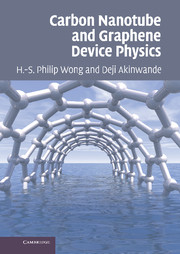Book contents
- Frontmatter
- Contents
- Preface
- 1 Overview of carbon nanotubes
- 2 Electrons in solids: a basic introduction
- 3 Graphene
- 4 Carbon nanotubes
- 5 Carbon nanotube equilibrium properties
- 6 Ideal quantum electrical properties
- 7 Carbon nanotube interconnects
- 8 Carbon nanotube field-effect transistors
- 9 Applications of carbon nanotubes
- Index
3 - Graphene
Published online by Cambridge University Press: 05 June 2012
- Frontmatter
- Contents
- Preface
- 1 Overview of carbon nanotubes
- 2 Electrons in solids: a basic introduction
- 3 Graphene
- 4 Carbon nanotubes
- 5 Carbon nanotube equilibrium properties
- 6 Ideal quantum electrical properties
- 7 Carbon nanotube interconnects
- 8 Carbon nanotube field-effect transistors
- 9 Applications of carbon nanotubes
- Index
Summary
Dream your dreams and may they come true.
Felix Bloch (developed the theory describing electrons in crystalline solids)Introduction
The objective of this chapter is to describe the physical and electronic structure of graphene. Familiarity with concepts such as the crystal lattice and Schrödinger's quantum mechanical wave equation discussed in Chapter2 will be useful. The electronic band structure of graphene is of primary importance because (i) it is the starting point for the understanding of graphene's solid-state properties and analysis of graphene devices and (ii) it is also the starting point for the understanding and derivation of the band structure of CNTs. We begin by broadly discussing carbon and then swiftly focus on graphene, including its crystal lattice and band structure. This chapter concludes on the contemporary topic of GNRs.
Carbon is a Group IV element that is very active in producing many molecular compounds and crystalline solids. Carbon has four valence electrons, which tend to interact with each other to produce the various types of carbon allotrope. In elemental form, the four valence electrons occupy the 2s and 2p orbitals, as illustrated in Figure 3.1a. When carbon atoms come together to form a crystal, one of the 2s electrons is excited to the 2pz orbital from energy gained from neighboring nuclei, which has the net effect of lowering the overall energy of the system. Interactions or bonding subsequently follow between the 2s and 2p orbitals of neighboring carbon atoms.
- Type
- Chapter
- Information
- Carbon Nanotube and Graphene Device Physics , pp. 47 - 72Publisher: Cambridge University PressPrint publication year: 2010



